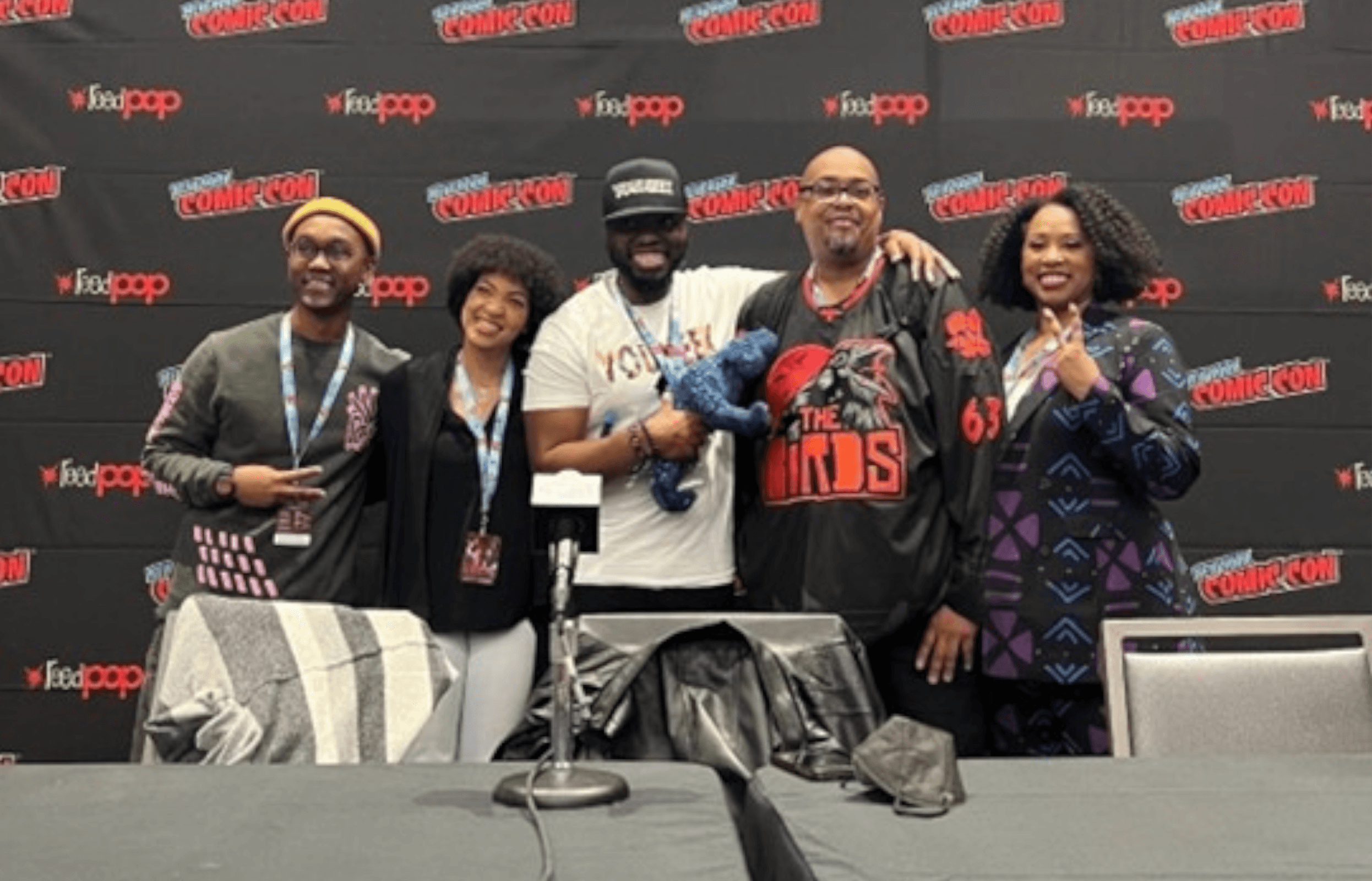Breaking Stereotypes Celebrating Black Anime Fans at Anime NYC '23
Sahtrese McQueen
Dec 21, 2023
Anime NYC is the biggest anime convention in New York City. It’s chock-full of anime nerds from across the country (hell, maybe even the world!) who come to indulge in our favorite Japan-centric content; it’s anime, cosplay, manga, art, and fandoms all in one. Anime NYC wasn’t my first rodeo; I’d been to the Liberty City Anime Con from 2017-2018 (before all doors closed in 2020), and both years were like a fever dream to me. At Liberty City there was beautiful art, and all my favorite characters walking right by me – it was like being a kid in a candy store.
However, it was overwhelmingly obvious then that not many “skinfolk” were dressing up as their favorite characters – or had panels oriented around our interests in this larger community, let alone being featured in any. As the years have flown by, and as Black interest in this area has grown, we’ve absolutely created a larger space for each other and accepted each other for what we are: good old-fashioned weebs. As the 21-year-old I am now, I was hoping for a smoother experience at Anime NYC due to how we’ve progressed over the years. And I have to say, I was pretty pleasantly surprised!

Poster of “Solo Leveling” at the Jacob K. Javits Convention Center during Anime NYC weekend | Photo by Sahtrese McQueen
From the start, I was fairly excited about the weekend ahead. The panels were promising, and I was chattin’ on social media about all the Black cosplayers I had the pleasure of seeing. Something about seeing Black people fully embracing their interests and glowing in their aura as they walked the convention halls just had me cheesin’. (And, you know, the sexy adventurers’ outfits they were wearing didn’t hurt, either.)
Kinks and Curls Panel
The first panel I attended was “Kinks and Curls: Ethnic Hair in Cosplay,” hosted by cosplayers Michael Allen, Chris Carthern, and Yesenia Moises, and moderated by Vanta Black. The room was a bit smaller than the other panel rooms and much further away from the remainder of the convention rooms. I almost got lost on my way there since the larger main rooms were all next to each other. I’d passed by that hallway maybe four times before turning the right corner and scurrying into my seat. (As the convention continued, I’d start to get real familiar with that small corner room of shame, but more on that later.)

From left to right: Michael Allen, Chris Carthern, Yesenia Moises, and Vanta Black at the “Kinks and Curls” Panel | Photo by Sahtrese McQueen
The room was full of POCs, listening intently to the panelists as they shared quips and quirks about their cosplaying experience. The panelists took on a range of questions from Vanta and then audience members towards the end, giving the newbies a bit of help on the right way to style a locked wig for a Gojo “loc”-splay (shoutout to Michael Allen for the baller wordplay here). I loved how the conversation veered into how Black hair is presented in Hollywood, too, outside of cosplay. For example, if the design and effort are low-quality in film, who do we look up to for inspiration?
After the panel finished, Anime NYC quickly kicked everyone out in preparation for the next panel (and every panel in that room since it was pretty booked with random niche-event topics). But, I connected with some of the panel members later. I wanted to see how the “Blerd” circle feels about the community around them, so I decided to interview anyone who wanted to talk about it.
Panelist Chris Cartharn (cosplaying as Invincible’s Bulletproof) has been cosplaying since 2017 and has dedicated so much to this passion in the anime community that he’s co-produced a Black animation project called Captain Zero. He mentioned some of his favorite things in the Black anime community: “I love it. I love being a part of a community and creating support groups, building real friendships over the fandoms we have in common, and showing our creativity. I like including things such as our natural hair and taking on our own interpretations of characters we connect with. We need more representation because we are a part of this world, and art should reflect that.”

Michael Allen (right) and Chris Carthern (left) at Anime NYC Day One | Photo by Chris Carthern, Instagram
I also caught Invincible’s Omni-man (panelist Michael Allen) on the way out. He, too, was on the panel; he’s been watching anime for 28 years and cosplayed for seven. He shared his tips and tricks for styling natural hair (I mean, seriously, the Aizawa locs went too well with his character…) and how he’s felt about being Black in the anime community. “I feel we deal with racism from everyone who isn't Black. It's almost like they don't want us to like anime.” This isn’t a foreign feeling; repeatedly, I ran into people who were enjoying the convention but had comments on how we’re treated and viewed as anime fans. It made me think that maybe how we experience conventions isn’t about the convention itself but how we’re treated as a whole in the anime community.
Anime-Inspired Hip-Hop Panel
I’d venture into another panel that surprised me with a topic I wasn’t as aware of: “Anime Inspired Hip-Hop Creating Culture and Community,” with panelists like rapper Shao Dow, entrepreneur Stan “Substantial” Robinson, DJ Chris Cardwell, and moderated by Hilton George. The panel discussed what motivations and inspirations they’ve garnered through anime. The host of this panel, Blerdcon (Black Nerd Convention) founder Hilton George, was pretty active all weekend – jumping from one corner of the convention to another. It was obvious that they were working with Anime NYC to further bring Black nerds together. I wasn’t aware of Blerdcon until this weekend, but Hilton always had a smile on his face when we caught each other in passing.
The panelists spoke on various topics, slightly veering from the main topic (as usual) to discuss the larger conversation: being Black and navigating the world (especially in a space that has made us feel excluded). “There was not this unified community of people that felt comfortable coming together -- you know, forty, fifty people doing Black Panther cosplays, and coming in and lobbying to have representation on the stage ... Having Black artists on stages at non-Black events is a relatively new thing, even in the nerd space. And we’re making this progress because people got up at eight o’clock in the morning, fought traffic, to come here and have this conversation.” Hilton would lament, and it was true: The more attention we brought to these panels, the more it proved how we longed for a space where we could all relate with one another.
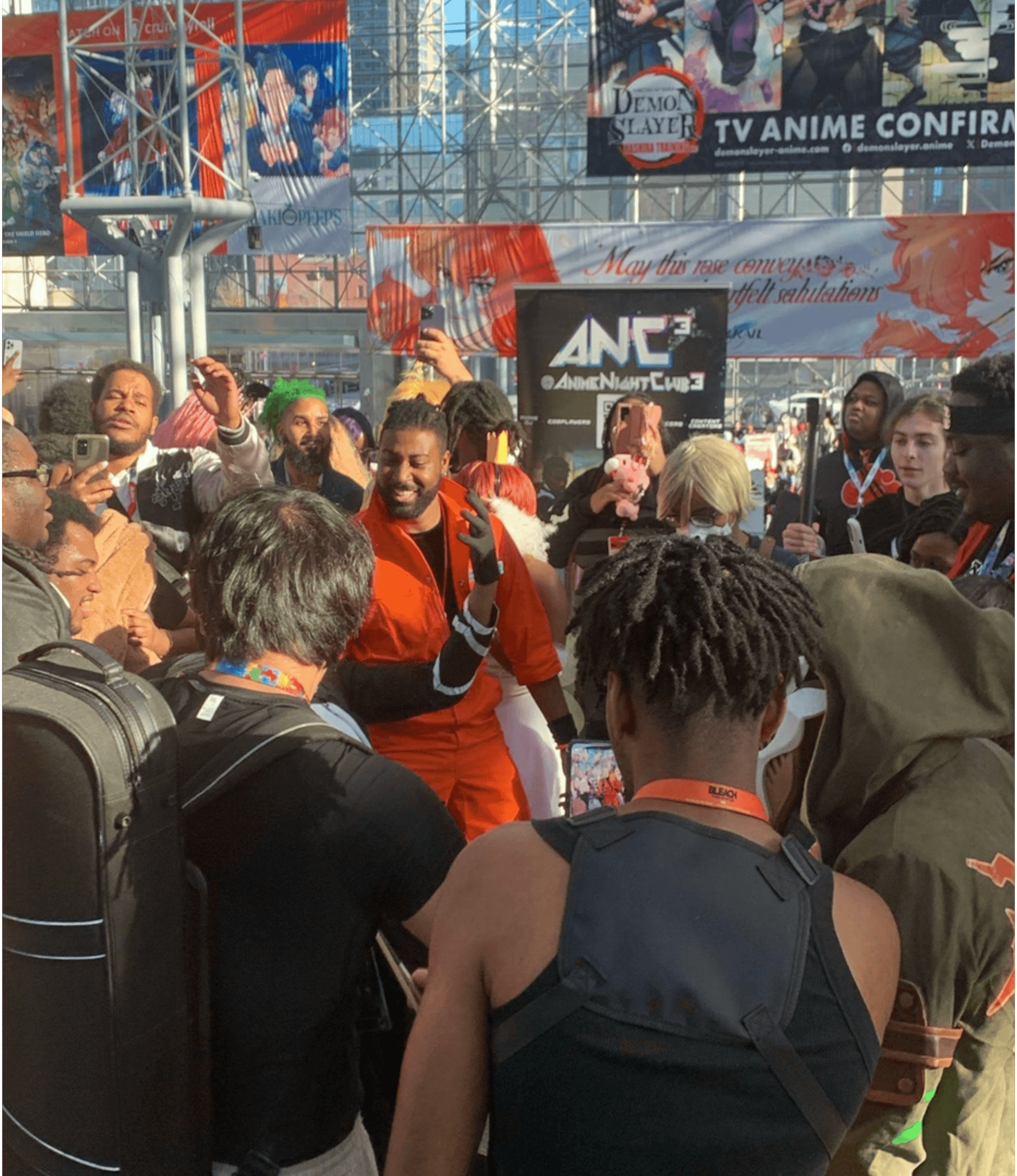
Dance circle forming during Anime NYC weekend, getting hype to the “iCarly” theme song | Photo by Sahtrese McQueen
Shao Dow, an award-winning rapper from the UK well-known for his music mixes between English and Japanese, was another panelist and has been an anime lover for around 20 years. He’s familiar with the days when being a young Black boy into anime was “considered weird,” but now he feels it’s weirder not to be into anime. Of the changes he’s seen and the Black representation he has (and hasn’t!) witnessed, I got to ask him how he feels about how Black people are represented in anime.
“We come to realize that POC have never had a space in this world. Which is why, in turn, white people begin to question why we take up space with our cosplays, and our interests in anime.”
“I would hate for, you know, Black people to be added into anime in a false, kind of ‘pandering to the masses’ type thing. I think it needs to be natural ... I like to see people in characters who look like me in my favorite things, but I don’t want it to be forced or shoehorned in ... And the thing with cosplay that I absolutely love is Black people, Asian people, etc. are cosplaying as their favorite characters who don’t share their skin color but are doing it in their own way. I like to see that.”
From discussing how sometimes the Black community can exclude us first because our interests deviate towards what’s considered atypical to the substantial dropping knowledge on Black organizations and conflict resolution through hip-hop culture, I felt my perspective expand a bit on our relationship with the genre and how we interact with other spaces through this medium. It was a good way to start the day!

From left to right: Shao Dow, Stan “Substantial” Robinson, Hilton George, and Chris Cardwell | Photo by Sahtrese McQueen
Cosplaying as a POC Panel
Arriving at my next panel, “Cosplaying as a POC” (the most interesting panel for me), I started noticing a pattern. Most of these “alternative” panels discussing being a POC or Blerd ended up in the same room, where there was either just enough space or not at all. I wasn’t going to let this ruin my enjoyment of the panels, but it was something that I paid attention to for the rest of the weekend. (The panel I attended after this one, “Blerd and Powerful,” would also be held in this room.)
“Cosplaying as a POC” shifted my thoughts. The conversation somehow articulated ideas veiled underneath these discussions, waiting to be addressed. Everyone in the room was very vocal -- talking in depth about how it’s difficult to list off POC characters on TV and how our default “hero” being male and white deems anything else a deviation, always making them “representation.” And everyone groaned when the slide about Twitter (#itwillneverbeX) complaining about Starfire’s character being Black in 2018 came up despite her being a literal alien.
It came to a head for me when discussing POC inside of the context of anime -- and one fan’s thoughts ring in my head, even now. Sarah-Anne Gresham brought up a fair point that anime has never focused on creating a holistic perspective for POC outside of white people and those who are Japanese; it’s a constructional issue, one where these worlds are only made to celebrate whiteness and look down on Blackness. How much anime takes the time to genuinely care for character creation and accuracy within the scope of a Black, Latino, or South Asian body? Compare this to the main characters, who are white, and we come to realize that POCs have never had a space in this world.
This is why, in turn, people begin to question why we take up space with our cosplays and our interests in anime. It's why white people don’t get nearly the same pushback when taking on a Japanese character’s cosplay as other POCs do. From the start, we’ve all had one image regulated to us. So, now that a new image in the form of POC cosplayers has emerged, there’s a sense of change that results in unwarranted attacks.
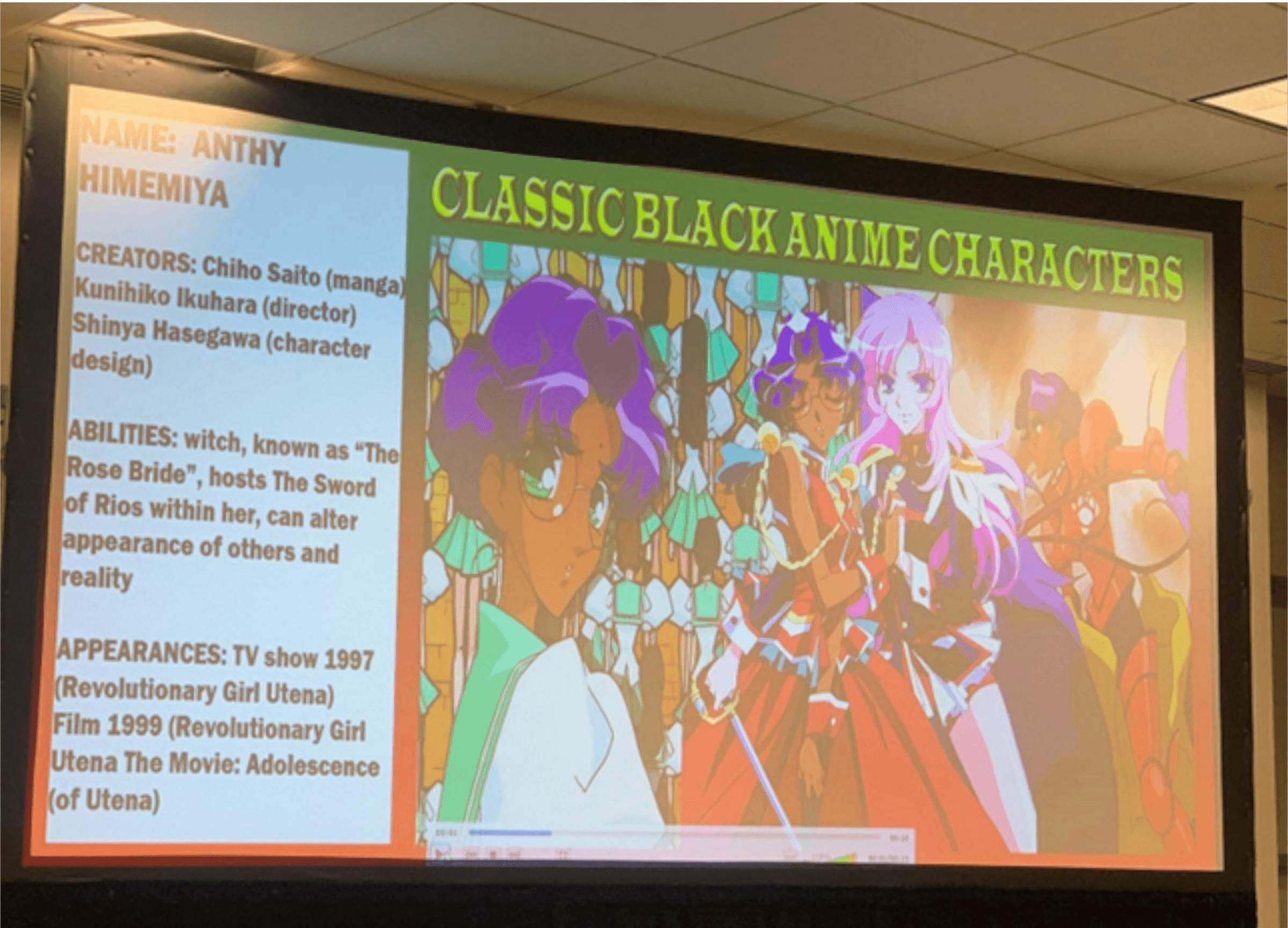
Panel describing Classic Black Anime Characters during Anime NYC Weekend | Photo by Sahtrese McQueen
I'm not going to lie; my mind was kind of blown. It had always been in my mind but never articulated until it was discussed at this panel. I had a lovely chat with Sarah-Anne after this panel, in which I found she was studying this topic and had so much to share. Again, I found comfort in these conversations with the surrounding community. I felt a sense of understanding in someone who knew what existing as a Black woman in the anime community was like but wanted to figure out how the system worked so it could be changed.
Blerd and Powerful Panel
“Blerd and Powerful” told a similar story, with each panelist coming to represent a brand or Black convention. They all chatted about the desire to make things within our community and to keep them for our community – how important it is to support Black-owned, Black-nerd, and Black-represented things because it prompts more of what we need from Hollywood and beyond. By this time, I saw more familiar faces, and walking around the convention felt nicer. I know that other cosplayers and fans were walking the convention with kindred experiences.

From left to right: Hilton George, Jason Richardson, Demetrius Holt, and Tony Weaver Jr. | Photo by Sahtrese McQueen
Hip-Hop and Anime Soundtracks Panel
On Sunday, there were only a couple of events Anime NYC had to offer oriented around Black topics -- but it was an early ending day, so I was simultaneously excited for these last few panels and excited to go home and reminisce on the experience. The one that stood out was a closing event and felt like a big finale: “Hip-Hop and Anime Soundtracks” with Paranom and Aztech from Hybrid Thoughts, who are some of the most featured hip-hop artists in anime soundtracks (Jujutsu Kaisen, Beastars, Sakugan, etc.). This was their second year at Anime NYC, and when I say the room was packed, I mean I’d never seen good ole’ Panel Room Five so full (and I think Paranom would agree since he reposted my comment about it)! So many came to hear these two chat about what it’s like to make hip-hop for anime soundtracks and how they’ve come to this point in their careers.
“Aztech and I are the most featured hip-hop artists of all time in anime – and success to me would include that status not only being acknowledged and celebrated, but open doors for us to have more input and say into how hip-hop is represented in anime.” (Paranom, 2024)
It was great to see how much attention this panel got, and I wish it were held in a room to accommodate the people who were interested. This makes me hope that next year, there can be an opportunity for some of these panels to be held in a larger room.

From left to right: Aztech, Shao Dow, and Paranom posing for a photo | Photo by Shao Dow, Instagram
Paranom, who’d been introduced to music at a young age through his mother’s youth choir and has been making it for over 20 years, felt the same gratitude in embracing this “nerdy” side of himself. “I love that Black people have found more things to connect with, being that sometimes it's hard to feel connected to those so-called ‘weird’ parts, or even authentic parts of ourselves living in this society. We kind of find escape and something that resembles a thing we can connect to at the same time.”
I was interested in knowing what this means from his perspective -- being Black and eminent as a hip-hop anime artist -- and how it falls unto the community surrounding him. He said, “To be Black and successful in this space would be for me to be able to hire another Black person to work on an anime soundtrack, with no red tape or micromanagement. Aztech and I are the most featured hip-hop artists of all time in anime – and success to me would include that status not only being acknowledged and celebrated, but open doors for us to have more input and say into how hip-hop is represented in anime. Success to me would be compensation for the mutual benefit of the utilization of my cultural background and unique expertise and artistry, instead of being used for a product in a corporate model that doesn't pay the people who use huge efforts to make each anime up to the great standard we want them to be in every aspect.”
With this, I would shut my notebook and enjoy the last of Crunchyroll’s new releases and Artist’s Alley before closing up shop myself, being left to reflect on the weekend that flew by me.
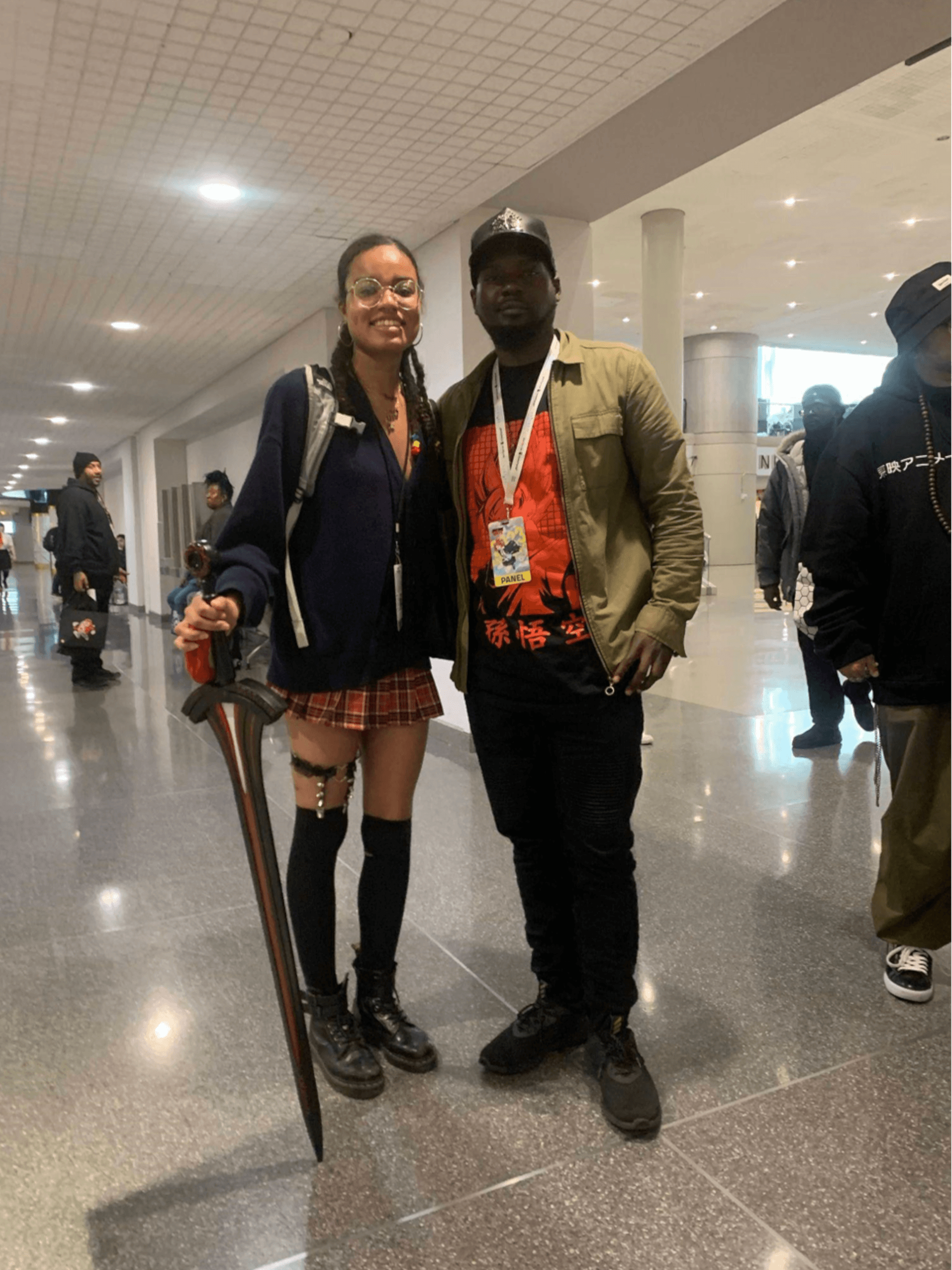
Shao Dow and I taking a picture during Anime NYC Weekend | Photo by Sahtrese McQueen
Anime NYC: The Black Experience
Between all of the panels rang one thing: At the end of the day, Black people will create spaces for us to gather and thrive in. There is still a lot to be done (and undone) in our community, but chatting with so many Black cosplayers, convention CEOs, artists, and Blerds made me feel a sense of belonging -- which comes down to the community more than the convention itself. I adore Anime NYC for all the panels held, but the organizers and panelists still proposed the idea. All Anime NYC had to do was okay the event.
This leaves me to look at this not really for the contents of the panels but for the handling of the events. As mentioned, our hidden little Panel, Room Five, hosted most of the minority-centric panels I visited this weekend. Once a panel concluded, we were rushed out while many of the other, bigger panel rooms were empty as I walked by. I get testing out a panel for the first year or two warrants a smaller space, but there could’ve been a great opportunity here to give these panels a chance in the main area. They could have garnered greater attention from those who weren’t aware of the panel but were interested. Most of these rooms weren’t being used the few times I walked by, but some panels in Panel Room Five made convention-goers squeeze in. This was my main gripe for the weekend, so let's hope that Anime NYC will have a better space to fit their audiences’ interests next year.

Entrance of Jacob K. Javits Convention Center during Anime NYC weekend | Photo by Sahtrese McQueen
Otherwise, the panels had amazing speakers, and I truly felt like I received a lot of insight over these three days, not just from my own experience but from so many other Black fans -- the good, homey feelings and the bad, isolating ones. It was all put out there. More than the convention itself, I did appreciate how many panels revolved around Black people within this space.
Overall, I’d give Anime NYC a solid 7/10! Whether it was dancing to Blerdcon’s music at a booth, running into groups of other Black anime fans and talking with them, or starting a dance circle in the middle of a pavilion to the iCarly theme song, we always seem to gravitate towards each other. In the smiles and the compliments, it’s good to feel recognized at a place where you’re showing a true version of yourself, and I’m glad Anime NYC had a hand in that.
So, I’ll see you next year, Anime NYC! (And let's shoot for a couple more events in the bigger panel room this time, yeah?)
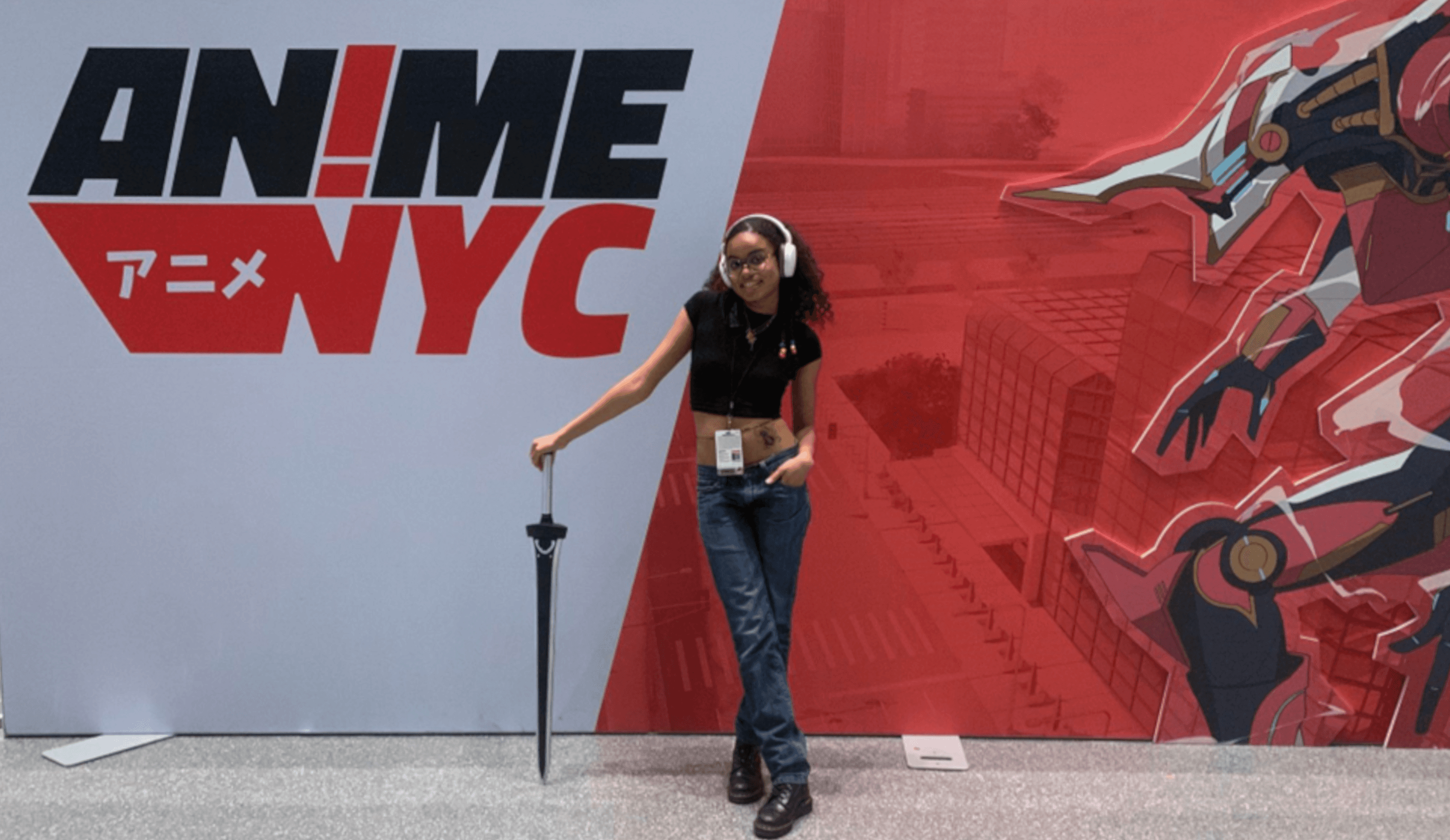
Me posing in front of the “Anime NYC” sign by Jacob K. Javits Convention Center entrance | Photo by Tia Monté


